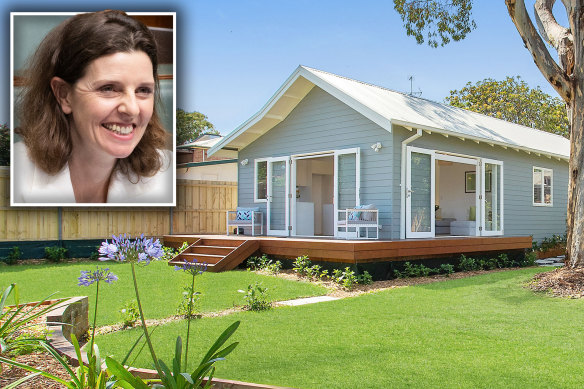By Rachel Clun
Homeowners should be allowed to rent out their spare rooms or granny flats without facing a tax penalty, independent MP Allegra Spender says, as a new report shows Australia’s housing crisis will worsen in coming years.
The National Housing Supply and Affordability Council’s State of the Housing System 2024 report found the federal government’s ambitious target of getting 1.2 million homes built in five years will fall short by more than 250,000 homes due to building industry constraints, complex planning processes and a lack of land to build on.

Allegra Spender says home owners should be able to rent out granny flats and spare bedrooms without capital gains tax implications.Credit: Alex Ellinghausen, Supplied
The report found housing affordability worsened in 2023 from already bad levels. Minimum repayments on mortgages had risen by as much as 60 per cent since the Reserve Bank started lifting interest rates in 2022.
Renters also faced enormous pressures from skyrocketing rents – which rose by 8 per cent last year – and a near record lack of availability. The national rental vacancy rate was 1.6 per cent.
That lack of rental affordability has put pressure on public and community housing, the report said, and waiting lists for public housing also rose over the last financial year while homelessness has also risen.
National Housing Supply and Affordability Council chair Susan Lloyd-Hurwitz said Australia’s housing market was “far from healthy”.
“At its heart, this crisis is about insufficient supply,” she said.
The council report found supply problems could worsen before they improved, and that the supply of new housing would stay below its long-term average for the rest of the year due to the low level of building approvals.
The latest building approval data from the Australian Bureau of Statistics shows that on a trend basis, home approvals fell by 1.1 per cent to 12,510 approvals over March, taking the annual fall in approvals to 7.3 per cent, the lowest trend approval rate since April 2012.
The council expects new housing supply to average about 176,000 homes per year, and it projects 903,000 private dwellings and a further 40,000 social and affordable homes will be built during the five years the government is aiming to get 1.2 million homes built, a shortfall of 257,000.
“In total, net new market housing supply is expected to be 1.04 million dwellings over the council’s six-year projection horizon,” the report says, noting the projections do not include state and territory measures that are expected in response to the national housing accord. At the same time, demand is projected to increase by 1.08 million households.
“The council’s projections indicate that new market supply will fall short of new demand over the next six years,” the report says. “As a result, housing affordability is expected to deteriorate further over the forecast horizon.”
But the report also found there were 6 million “excess” bedrooms on census night in 2021, and nearly 4 million homes had two or more spare bedrooms.
Spender said there was a short-term opportunity here for the government to help ease the rental crisis.
“[It’s] actually pretty simple, and it’s something that we should at least consider or look at [in the] short term,” she said. “How do we unlock those spare bedrooms?”
Spender said there were plenty of older people with spare bedrooms or a granny flat, but renting them out would mean losing the capital gains tax discount on the rented portion of their home, which could have huge financial implications for people approaching retirement.
“The potential impact on you financially is enormous,” she said.
Spender wants the government to remove that capital gains tax implication, at least in the short term, so people could rent out their spare rooms without facing a tax penalty to help free up more housing solutions for renters. It’s a solution that would also not cost the federal government much money.
“I’m in a community of 45 per cent renters. It’s a really hard moment out there for that community,” she said.
“If we can bring some more supply on … even just for the next two, three years, while we’re trying to sort out the supply, I think that could make a real difference.”
Housing Minister Julie Collins acknowledged the challenges in Australia’s housing market were ongoing, and that the government’s 1.2 million target was ambitious. In the October 2022-23 budget, the target was 1 million homes.
“Our party has never been afraid of a challenge,” she said in a speech launching the State of the Housing System report. “We’re not pretending this isn’t going to be hard addressing challenges that have developed over decades are. But we’re putting in the work.”
Collins said the government had invested $25 billion, including the creation of the $10 billion Housing Australia Future Fund, into addressing the housing crisis and getting more social and affordable housing built.
But beyond government spending, independent senator Tammy Tyrell said the government had to look at how migrants could help fill trade shortages to get more homes built.
“Homelessness can happen to anyone. I’ve been on a public housing waiting list. I know what it’s like to have a pit in your stomach every day, not knowing if you’re going to have a roof over your head that night or not,” she said.
“Money for housing is always needed, but it’s a bit redundant if there’s no one around to build them.”
Opposition housing spokesman Michael Sukkar said the housing crisis was getting worse under Labor.
“Sadly, this government is completely out of ideas and the only housing policies delivering support to first home buyers are the housing policies Labor inherited from the former Coalition government,” he said.
Cut through the noise of federal politics with news, views and expert analysis. Subscribers can sign up to our weekly Inside Politics newsletter.